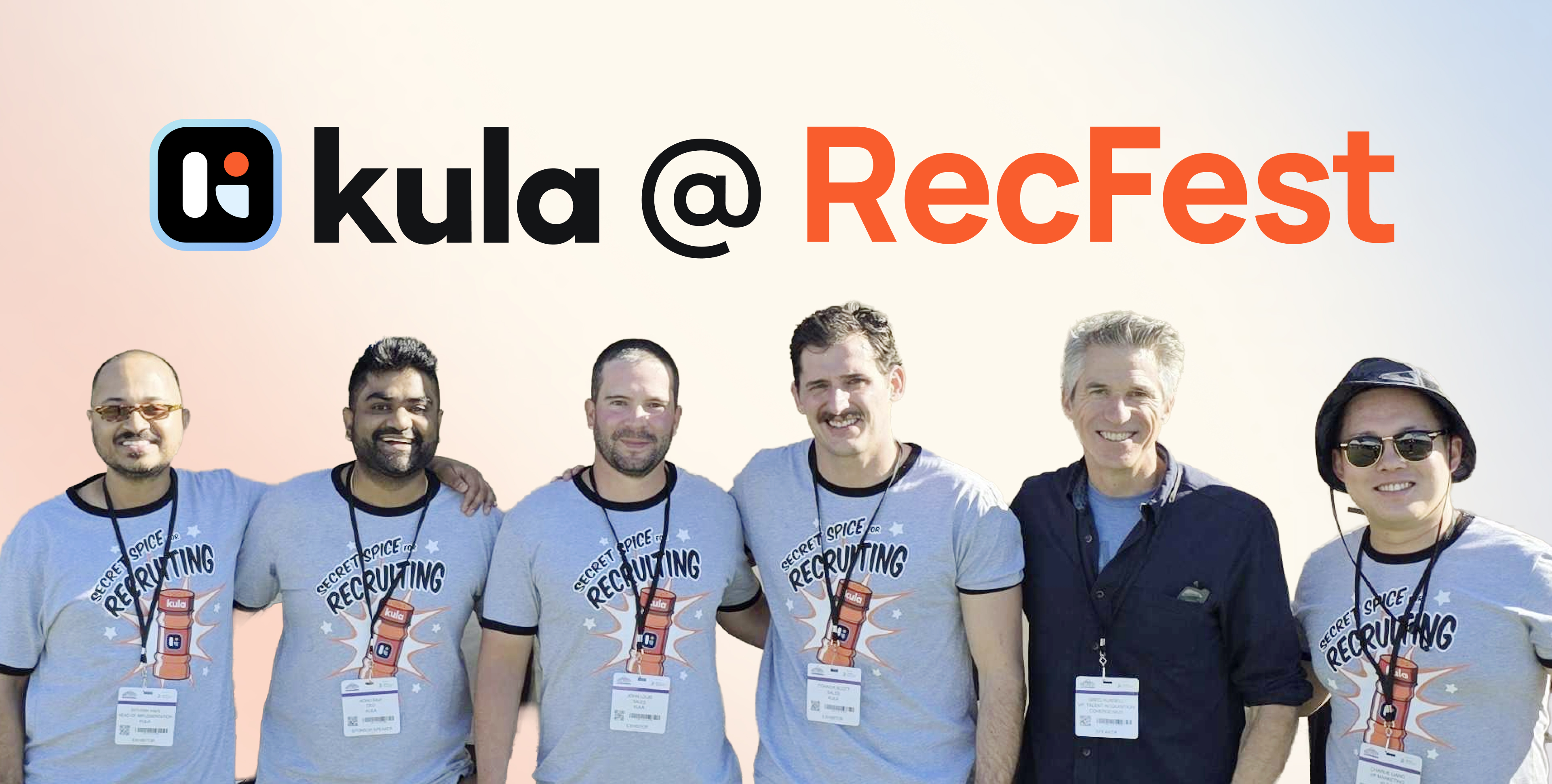Book a 30-minute demo and learn how Kula can help you hire faster and smarter with AI and automation
Recent estimates suggest that nearly 75% of employers struggled to find qualified candidates in 2023. Undoubtedly, recruiting comes with a unique set of challenges every year.
From overflowing inboxes to keeping up with effective metrics, optimizing your hiring workflow is easier said than done.
On top of that, LinkedIn’s Future of Recruiting 2023 report suggests that 68% of hiring professionals are optimistic about using AI for automating manual tasks. But what is the best way to leverage it?
Also, how do you hire the top performers but with fewer people, leaner budgets, and a brand-new ecosystem?
In 2024, attracting the right talent doesn't need to be complicated.
In this article, we'll go over the nine most common recruiting challenges and explore innovative strategies to overcome them so that you can streamline your processes, attract a wider talent pool, and establish a reputation as a sought-after employer.
Let's get started!
9 common recruiting challenges and actionable solutions
Here are some of the most common recruiting problems you could run into in 2024 and how you can solve them:
1. Attracting relevant candidates
Challenge: What do you do when you’re trying to hire the right candidates? Do you cast a wide hiring net?
Doing so would yield an influx of unqualified applicants and bog down your pipeline with irrelevant candidates. This will ultimately take your time away from qualified candidates, disappointing them with a haphazard system.
On the other hand —narrowing your search cannot be the answer either. You could miss out on potentially great hires because you didn’t target the platforms they were on.
Solution: So, what is the right sourcing scope? The solution is three-pronged:
- Conduct research and look at past hiring metrics to find platforms that yielded great applicants in the past.
- Write specific job posts to reach niche candidates passionate about your mission. This would attract the right people, but many unqualified candidates would also throw their hat in the ring.
- In anticipation, you could use knock-out questions upfront to filter for must-have skills.
Ideally, you would combine all three strategies, but two also work.
Tip: Share employee stories showcasing your culture as a magnet for top performers who seek deeper purpose, especially if you’re hiring for a founding team.
2. Engaging passive candidates
Challenge: Are the best candidates already happily employed elsewhere? Many talented professionals aren't actively job-hunting, making them 'passive candidates.' Standard outreach won't be enough to pique their interest.
Solution: To attract passive candidates, focus on the unique value you offer. Remember, they're likely content in their current jobs; you must show them something genuinely compelling to consider a change.
Maybe you offer the excitement of a fast-paced startup, appealing to someone tired of a slow corporate environment. Or perhaps your company is known for its inclusive culture, attracting a person of color seeking an environment where they feel valued.
Tip: The key is personalization. Tailor your messaging to each individual, pinpointing what would motivate them to make a move.
3. Hiring quickly
Challenge: If you’re taking weeks to hire and asking your candidates to sit through interview after interview, you’ll lose them to more agile companies.
Solution: To remedy this, you need to take a good, honest look at your current hiring process:
- Do you need so many hiring stages?
- Are some stages taking longer than others?
- Do hiring managers take forever to give you feedback, or is scheduling interviews a nightmare?
Analyze metrics around application volume, candidate progression, and feedback timing to isolate delays. Perhaps you need to reduce the number of stages or work on a streamlined scheduling system that doesn’t hinge on email back and forth.
Tip: An all-in-one, AI-driven applicant tracking system such as Kula can help you with scheduling features and automated interview feedback reminders. It also provides the metrics you need to identify bottlenecks.
4. Data-driven decision making
Challenge: Tired of drowning in spreadsheets and biased decision-making? Manual processes are inefficient, and relying on gut feelings leads to unfair hiring practices.
Solution: Use purpose-built applicant tracking system software that supports integrations to simply plug in data without manually entering it.
Anonymize applications so interviewers keep unconscious bias out of the equation. Centralize candidate data and surface actionable insights via automated reports.
Flooded by metrics? Identify 2-3 key hiring metrics to sharpen focus.
Tips: Kula’s data-driven ATS platform streamlines your search for the ideal candidate. Its advanced search taps into integrated resume databases for optimal discovery. You can also track the effectiveness of your sourcing with insightful reporting.
5. Strengthening employer brand
Challenge: Your company might be amazing, but how do you get top talent to notice when you're not a household name? Building a strong employer brand is crucial, but it can feel like an extra job on top of your recruiting duties.
Solution: You need a system that effortlessly personalizes and distributes your brand communications consistently. It should also add a personal touch to every email, job post, and social media post without manual intervention.
Tip: Kula ATS’ out-of-box career page builder takes care of web development and design work and enables you to push out branded company assets in a matter of days.
Also, triggered workflows can send candidates personalized communications based on changing hiring stages or actions you specify.
6. Delivering a standout candidate experience
Challenge: In a razor-thin talent market, candidates expect ultra-responsive, personalized interactions when exploring roles. Clunky processes frustrate and tempt candidates to bounce even after they’ve accepted an offer.
Solution: Set clear expectations for communication cadences upfront. If you’re going to respond in two business days, say so. Offer self-scheduling features so they can sync your hiring process to their calendars.
Create structured onboarding checklists so you don’t miss out on important steps that delay a candidate's ability to get into a job.
Tip: Kula ATS simplifies the application process for both candidates and recruiters. On any device (mobile, tablet, laptop, or desktop), candidates can apply for jobs or express interest in a single click without creating an account.
They can also apply directly using their LinkedIn, Indeed, or Facebook profiles or upload a traditional resume. This streamlined experience attracts a wider pool of qualified candidates and improves your hiring efficiency.
7. Eliminating unconscious bias
Challenge: Unconscious bias could be sabotaging your hiring. No matter how well-intentioned your team is, we all have blind spots that unfairly impact our judgment of candidates.
Solution: Briefings and training help, but the most effective way is to change the system.
Anonymize applications to remove irrelevant factors like race and age, focusing on skills alone. Implement DEI reporting to track patterns, identify potential bias areas, and take proactive corrective action.
It won't be perfect, but these tools create a fairer playing field for all candidates and help you build a truly diverse and talented team.
8. Aligning virtual teams
Challenge: Remote work is awesome, but how do you keep everyone on the same page? Schedules get messy, time zones clash, and it feels like your team is never in sync.
Solution: Project management software keeps everyone accountable, no matter where they're working. Try asynchronous communication tools like Loom for in-depth feedback without needing a live meeting.
Also, don't forget the social side! A weekly team-building activity (even a short one) can boost morale and keep everyone connected.
9. Winning the war for talent
Challenge: Feel like you're always outbid by tech giants for top talent? Smaller budgets can make it tough to compete on salary alone.
solution: Focus on the factors you can control. Showcase your company's unique culture, emphasize growth opportunities, and highlight accessible leadership.
Take a page from Google's playbook – a positive reputation can be as attractive as a hefty paycheck.
Remember, smart recruiting isn't just about money. By building a compelling employer brand and offering a fulfilling work environment, you can still attract top talent – even in competitive fields.
5 best practices to avoid common recruiting challenges
Follow these five tips to increase hiring dividends over time:
Build a talent pool
Candidates often try to build a list of warm leads they can contact should they ever need to switch jobs. Recruiters should maintain an ever-ready bench of interested candidates for sudden openings.
This is critical for mid-senior to senior roles as these are harder to fill. When you build a talent pool, you have access to a pre-vetted group you already know how to approach.
At the same time, they’re already familiar with your culture and know what to expect, reducing churn in the long run. This saves you immense hiring and retaining effort.
Train teams
Your team needs to be trained to be efficient and fair in their practices. Teach them the latest tactics to avoid bias and gain superior recruiting skills.
You can do this in two ways, build an internal course or sign them up for existing ones created by a recruiting expert.
Take Harvard's Implicit Association Test
Harvard Implicit Association Test measures bias by assessing how test-takers associate groups of words and images under timed conditions. This is a quick way to measure existing attitudes and stereotypes. This enables you to:
- Focus interviews strictly on job-relevant qualifications to minimize bias.
- Research blind recruiting tools (which hide initial demographic details) and consider a pilot program.
- Track inclusive hiring metrics – measure application conversion and offer acceptance rates across demographics to spot potential biases.
Diversify sourcing strategies
While we encourage you to identify the hiring channels that bring you the highest number of qualified candidates, narrowing your search too much might mean you’re missing out.
Don’t spread yourself too thin by targeting every channel you can think of. Rather, keep yourself updated on newer communities with a network you can reach out to for open roles.
For example, Peak Freelance, Superpath, and s11s are great platforms you can leverage if you’re looking to fill marketing roles in the future.
Automate administrative tasks
You’re spending far too many hours on manual logistics — scheduling interviews, drafting repetitive emails, gathering documentation — instead of engaging candidates. These administrative tasks are important but drain recruiting velocity.
Rather than endlessly coordinate calendars or copy-paste yet another email template, leverage tools to automate these rote functions.
Kula ATS helps you organize talent into pools based on skills, location, experience, and more for easy targeting. You can automate personalized communication at every stage of the application process, with all correspondence captured for future reference.
Also, streamline scheduling by integrating with popular calendars (Google, Microsoft Exchange, Outlook 365), allowing interviewers to easily manage availability. Plus, you can offer convenient self-scheduling options that empower candidates to book their own interviews.
Tackle recruiting challenges better with Kula
Common recruiting hurdles like attracting scarce candidates, engaging passive ones, hiring quickly, and minimizing bias have achievable solutions if you approach them systematically.
Kula ATS can help you implement these systems by offering:
- Customizable career site builders optimized for candidate experience
- Personalized email templates to engage talent at scale
- Automated updates to build rapport between you (the recruiter), the candidate, and the hiring manager throughout the hiring process
- Customized reports with applicant metrics like time-to-hire and source of hire
- One-way video interviews with preset questions to efficiently screen candidates
- DEI tracking to monitor diversity along the hiring funnel
With Kula ATS, you hold an actionable framework that effectively solves wide-ranging hiring challenges.
To learn more, schedule a demo today!






















